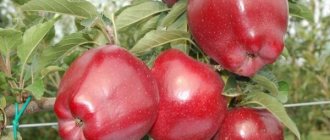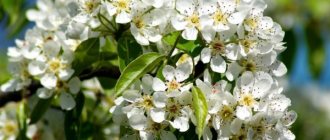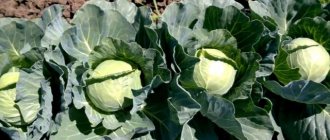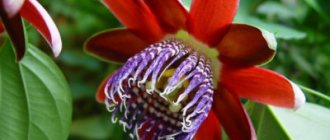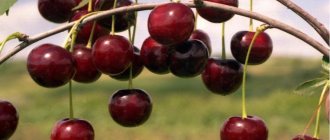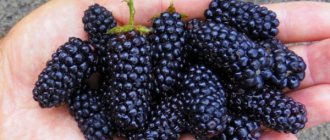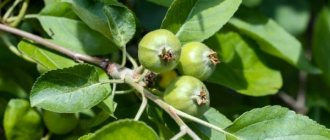This delicious mulberry!
The leaves of the plant are the main food for the silkworm, whose cocoons are the main material for producing silk. By the way, black and white mulberries differ from each other not in the color of the berries, but in the color of the bark of the branches: in white mulberries it is light, in black mulberries it is an order of magnitude darker. The fruits of this plant, loved by adults and children, contain a large complex of vitamins, which makes consuming this product not only pleasant, but also healthy. Black mulberry is the basis for delicious preserves, jams and compotes; fermentation of the berries produces excellent wine; distillation produces mulberry vodka. Of course, fresh mulberry fruits are most in demand.
Features of cultivation and care
To reap a large harvest that will be marketable, you need to choose the right planting site and seedlings. After this, you need to prepare a place for planting, because the mulberry tree will not bear fruit in shaded areas.
After planting is completed, it is necessary to take care of the quality of care. Trees need plenty of water and nutrients. Do not forget that you need to annually prune old branches and prepare the plant for the coming winter.
Choosing a landing site
To plant the Black Baroness mulberry variety, you need to choose an area that will receive a large amount of sunlight. If the plant grows in the shade, the berries will be small and sour. There are no special preferences in choosing soil. The only condition is that the acidity of the soil must be low (pH no more than 3).
Preparation of the site begins in the fall. The hole should be 50x50x50 cm in size. If desired, you can add 3 kg of humus to the planting hole to saturate the soil with useful substances. The distance between trees must be at least 3 m.
Planting and watering features
Trees should be planted in the spring, when the soil warms up to a temperature of +10°C. First, crushed stone drainage is laid at the bottom of the hole to protect the roots from waterlogging and rotting. This procedure is especially relevant if groundwater comes closer to the surface of the earth than 2-3 m. Soil mixed with peat (in a 1:1 ratio) is poured over the drainage. After this, the planting material is installed vertically.
Important! Install the seedling carefully so as not to damage the delicate roots. Spread the root system and cover with soil
Compact the top layer to prevent voids from forming. If water gets into them, this will lead to rotting of the root system and death of the plant. Immediately after planting, it is advisable to mulch the tree trunk. For this you can use leaves, sawdust or peat. A layer of mulch is necessary to maintain moisture levels. This will prevent water from evaporating when exposed to the sun.
Spread the root system and cover with soil. Compact the top layer to prevent voids from forming. If water gets into them, this will lead to rotting of the root system and death of the plant. Immediately after planting, it is advisable to mulch the tree trunk. For this you can use leaves, sawdust or peat. A layer of mulch is necessary to maintain moisture levels. This way the water will not evaporate under the influence of the sun.
Video: Planting and caring for mulberries
The Black Baroness variety can tolerate prolonged drought. If the gardener waters the trees in a timely manner, this will allow him to increase the size of the berries and the yield. Most often, mulberries need to be watered between May and August. At least 30 liters of water are poured under each tree. Before the irrigation procedure, the soil is loosened and large weeds are removed.
Feeding and pruning
There is no need to feed the seedlings for 2-3 years after planting. The plant will have enough nutrients that are added during the planting process.
After the specified period, fertilizing is added according to the following plan:
- In early spring (before the snow melts) feed with urea (100 g per 1 m²). When the snow cover melts, nutrients will seep in along with the moisture, which will best ensure that they reach the root system.
- At the end of August, a mixture of potassium and phosphorus is added (300 g of each substance per tree).
Pruning begins in early spring, until the buds have formed. To properly form the crown, it is necessary to remove the side branches. They are shortened so that no more than 1 m remains.
Forming a mulberry crown “on a fist”: a - cutting branches; b - formation of three “fists”
Mulberry trees also need regular sanitary pruning. They are carried out at intervals of 2-3 years. During their execution, all dry and damaged branches are cut off.
Important! If you do not do sanitary pruning, the plant will spend a large amount of nutrients on the restoration of shoots, and not on the formation of berries
Preparing for winter
Although the Black Baroness variety is resistant to frost, it is better to take care of preparing the plants for winter. The plant does not need shelter, because the trunk is not affected by frost. A strong drop in temperature negatively affects only young shoots and roots.
This procedure consists of several stages:
- mulching the tree trunk;
- removing green shoots (if they are not covered with dense bark);
- smoky fires that are created in the spring. They help protect trees from return frosts.
Disease and pest control
Among the diseases that affect mulberries of the Black Baroness variety are:
- Cylindrical sporiosis . It appears in the form of brown spots that are localized on the leaves. Over time, they acquire a black rim. If treatment is not started in time, the leaves will dry out, which will negatively affect the yield. Copper sulfate (40 g per 10 liters of water) is used in the fight.
- Curly small-leaved . First, graininess appears on the leaves, after which they curl inward. Over time, the foliage loses its color saturation. Treatment consists of treatment with Condor (20 g per 10 liters of water).
- Bacteriosis . The first symptoms of the disease appear in the form of transparent spots on the leaves. Over time, they become dark, after which the plate becomes thinner and holes form. Spraying with formaldehyde (30 g per 10 liters of water) will help fight bacteriosis.
- Verticillium wilt . In mid-summer, the leaves change their shade, and then become yellow and dry out. Treatment consists of treatment with Aktara solution (30 g per 7 liters of water).
On trees you can often find pests such as beetles and spider mites. Parasites that negatively affect the Black Baroness mulberry also include mole crickets and wireworms. The fight against beetles consists of treating with Arrivo solution (180 g per 10 liters of water). Tanrek (80 g per 5 liters of water) is used against spider mites. In the fight against mole crickets, it is advisable to use Confidor. It is enough to add 50 g of the drug into each hole along with corn grain bait. You can also control the pest manually. To eliminate wireworms, use Bombardir (70 g per 5 liters of water).
Spraying against diseases and pests is carried out in cloudy weather at intervals of 2-3 weeks. If you treat trees in hot weather, exposure to sunlight will cause burns on the leaves.
You will be interested to know how and when to harvest mulberries.
So, now you know what the Black Baroness mulberry variety looks like and what are the basic planting procedures for this variety. Try to provide the trees with proper care on time in order to get a large harvest. Despite the fact that mulberries have a short shelf life (no more than 12 hours), they are very popular.
Two forms of mulberries: white and black
Of the more than two hundred varieties of mulberries, two forms are widely known and widespread:
- Mulberry is white. At home, in the conditions of China and India, this is a huge (up to 10–12 meters in height) tree with a lifespan of up to 300 years. It is considered both a fruit and fodder industrial crop. The leaf reaches colossal sizes up to 25–30 cm in length. It is used as food for the silkworm, a producer of raw materials for silk. Known since ancient times.
- Black mulberry. The leaf is 6–17 cm long. It is considered a fruit tree. Produces clusters of small black fruits with a sharp but pleasant taste. The berries resemble blackberries in appearance.
The main external difference between white and black mulberries is the color of the fruit. It is called white almost literally because of the very light color of the bark. Moreover, ripe white mulberry berries can be of different colors: white, pink and even black.
Even the perennial branches of the white mulberry are light in color
In black, accordingly, ripe fruits are always black and have a darker bark.
Mulberry variety Black Baroness has good frost resistance
Features of harvesting
Already in the third year of development, most varieties produce their first harvest. The berries are still quite small, but this is enough to verify the varietal qualities of the planted plant. When the tree reaches 10 years, the fruits become large; the size must correspond to that declared by the originator. If you don’t have the time or desire to wait, you can use grafting of the queen cell onto the stem of a young specimen. This will speed up the formation of large berries by several years.
Harvesting is extended due to the gradual ripening of the berries. However, it does not take much energy, since there is no need to climb a tree or tremble it. When the fruits reach full ripeness, they fall off on their own. On the ground under the tree you only need to spread a thick cloth so that the juicy berries do not break when they fall. Ripening time depends on the specific variety.
White
Many people enjoy looking at photos of white mulberries. As a rule, silkworm, white and multi-stemmed mulberries are cultivated to feed mulberry silkworms. The fruits of such a plant can be not only white, but also yellow, pink and even black. This variety received its name due to the light bark of the tree.
This plant is native to East and Asia Minor. This is a tall, fast-growing, long-lived tree with a dense, spreading or spherical crown. The leaves grow on the same tree in different configurations; they are yellow in autumn and dark green in summer. The berries of this type of mulberry deserve special attention - they have an unusually sugary taste.
It is unpretentious to conditions and soil - it grows well in urban environments, and its long roots help strengthen ravines and slopes. Transplantation is easily tolerated at a young age. This species can withstand severe frosts (down to -30 °C). If young branches are frozen, they are cut off. Then they quickly grow back, and the tree restores fruiting.
Gardeners also grow white mulberry as an ornamental plant: there are a large number of garden forms with spherical, weeping, dwarf, pyramidal, multi-stemmed crowns and various leaves. Picturesque forms are propagated vegetatively and by grafting.
It is known that this plant is used for group planting, single planting and for creating a dense hedge, as it tolerates regular pruning perfectly.
Which mulberry has black berries?
Many gardeners mistakenly call absolutely any mulberry that produces dark-colored fruits black mulberry. In fact, at least half of the black-fruited varieties (including the well-known varieties Smuglyanka, Black Baroness, Black Prince) belong to a completely different botanical species - white mulberry, which has fruits of a wide variety of colors, from pure white to black-violet.
Mulberries are divided into black and white depending on the color of the bark, and not on the shade of the berries
Table: comparative characteristics of black and white mulberries
True black mulberry has large, broadly heart-shaped leaves.
Mulberry is one of the oldest cultivated plants, originally domesticated for feeding silkworm caterpillars, from whose cocoons natural silk is obtained. In the regions of industrial sericulture, mulberry trees of forage varieties, rather than fruit varieties, predominate. They are more hardy, so they are often used in shelterbelts and urban landscaping.
Mulberry leaves are food for silkworm caterpillars
Mulberries bloom in the south in April-May, in the middle zone - in May-June. Pollinated by wind and insects. In nature, mulberry is a dioecious plant, with male and female flowers located on different trees. Among cultivated fruit varieties, monoecious ones predominate, having both types of inflorescences on one tree. When seeds are sown, the characteristics are split, and among the seedlings there are many male plants. Therefore, valuable mulberry fruit varieties are propagated only vegetatively.
Flowering mulberries are pollinated by wind and insects
Mulberry fruits ripen in the south in May-July, in the middle zone - in July-August. The fruiting period is very extended. Ripe fruits easily fall to the ground. With normal pollination, mulberry trees bear fruit annually and very abundantly. If the flowering was good, there were no frosts during this period (which can damage not only the flowers, but also the leaves), and there are no or very few berries, which means the problem is a lack of pollination. It is necessary to plant a tree of a different variety nearby or graft suitable cuttings into the crown.
Sweet mulberries do not ripen at the same time
Dark-colored mulberries greatly stain hands and clothes, and stains are difficult to wash off.
Ripe berries become soft, juicy, sweet, they wrinkle easily and do not tolerate storage and transportation at all. Therefore, the crop is processed on the day of collection. Mulberries can be eaten fresh, dried, made into jam, or made into wine.
In good conditions, mulberries bear fruit annually and very abundantly.
In the south, mulberry grows up to 15 m in height, and in favorable conditions lives for a couple of hundred years, and sometimes longer. In the north, young growth freezes almost every year, and the plant often takes on a bushy form. Mulberry tolerates urban conditions well and is not afraid of car exhaust fumes.
Large mulberry trees are occasionally found in Moscow, and in bush form it is grown all the way to the Leningrad region.
Large mulberry trees are occasionally found even in Moscow
Principles of mulberry care
If you decide to plant black mulberry on a site, the cultivation of which does not require significant investments or knowledge in gardening, then remember the basic simple principles of caring for it:
Even though many varieties of this plant are not very demanding on watering and can withstand long droughts, watering is still necessary, especially in the first half of summer. Timely moistening of the soil from April to July with the addition of mineral and organic fertilizers will help the tree gain strength, produce a good juicy harvest and withstand severe frosts.
An adult mulberry tree of some varieties can be very tall and bulky, so in order for the plant not only to produce a rich harvest, but also to look aesthetically beautiful on your site, it is necessary to carry out sanitary and decorative pruning in early spring. If you want to get a tree no higher than 2 m, then the formation takes place with a trunk of 0.5-1.5 m.
This is the main thing that should be followed when planting black mulberry and caring for it when growing trees. Most often, shoots or green cuttings from an adult tree are taken for planting on a site. This method gives a very high survival rate, while maintaining all the characteristics of the mother variety.
Black mulberry does not require a specific type of soil when planting, as it easily adapts to almost any soil and will develop quickly. For example, when sand predominates in the ground, it gives good adventitious roots in order to gain a strong foothold.
When planting several trees, immediately determine how the crowns of black mulberry seedlings will be formed.
To make caring for them easier in the future and the plants do not interfere with each other, they need to be planted at a certain distance from each other:
- bush form: at least 0.5 m between plants, and row spacing - 3 m;
- tree: at least 5 m between plants, and the distance between rows is approximately 4 m.
When planting, you should handle the roots of the seedling very carefully, since they are quite fragile, but otherwise planting is not much different from such an operation carried out with other shrubs or trees.
Look at the photo of the black mulberry, where it appears in its full glory:
Forum statistics
207036 Messages in 1634 Topics from 5593 Users. Last user: Amaya Last message: “Let's talk about the weather in Vash...” ( Today at 07:52:22 ) Latest messages on the forum.
Now on the forum
79 Guests, 13 Users
Users in the last 15 minutes: Lyubov S., Ser, Erem, Polyanina Ekaterina, ElenkaF, kosmos, Yura, Evgeniy52, GALINA ANOKHINA, DorontsovPeter, ZaycevAS, Alex65, 77volt [Blocked] [Section Moderator] [Forum Moderator]
Maximum online today: 95 . All-time maximum online: 2758 (28 July 2021, 17:22:51)
Users who visited the forum in the last 24 hours
Total: 293
(Visible: 292, Hidden: 1) 1963, Lyubov S., Ser, Erem, Polyanina Ekaterina, ElenkaF, kosmos, Evgeniy52, Yura, GALINA ANOKHINA, DorontsovPeter, ZaycevAS, Alex65, 77volt, 64nikolay64, Vova Kapran, Vasily 53, zsb , Polina77, spotlight, Mikhail Alekseevich, Svetla777, Quiet, Marshal, Nikolay S., therapist, Liza, Capricorn, lomakin1969, Alexander Vl., Elvira2017, Andrey76, Slavka, Mikhail77, Tatyana B, Cherkessk, Eugene, Leonidych, vladimirM, yotmast , mers, Serg1707, SNovichek, hanter64, znakomij, Alexander K, Vardan, Sergey Fer, Anatoly Sivkov, Alexey V, Ilya 77, Andrey Gladilin, Tatyana A., Belgorodets, in Astrakhan, Oksana Kopp, sem_en, Vladimir 153, skier, Igor Viktorovich, slavalimon, Primorets, OlgaOs, SANYCH, 31rus, mystic69, Andrey Tsvetkov, Buba, igor222, Elena Z, vlad51, Kenig, Nikolay Rex, Sergey 1965, Vladimir Buturlakin, DSW, psv1960, Dmitry 77, Vasily V., Vyacheslav03 , Natalia Nikolaevna, Sergey Tashchiyan, Igor Sergeevich, alexsandr, kvg, Pioneer, nicson7, Elena Aleshchenko, Alexander-ask-34, Verona, Igor F., Taker, Henry, Yuri72, L.A.P., Gaivoronsky Yuri, Sergeevich Sergey Purekletov, Svetlana Streletskaya, Galinka, Aleksey Deminov, Naumov Igor, Vyacheslav136, Gravoyy, Katrin, Andsanych, Mikhno Alexander, Grandfather, Oleg, Vladimir ++, Lydia58, Alexander Bryansky, Vladimir-Kanevskay, Dil, Amber7394, Marina Protasova , TITOVA LYUBOV, Linx, alexander66, Natalya M, Mikhail Fesenko, Amaya, Alexander71, Boris 1952, tsv, Maximilian, 25nata35, nadia, Igor_K, Alexander Kolesnikov, Ivan Levin, Pitko, weather forecaster, eSAa, cecet71, atseton, Alexander Smirnov, Vladimir Kostochkin, Vladimir Berdnikov, Gocha, pioneer-2, LeXa_KoT, Sergey 61, Sergey Yuryev, alexss, Skif, Vladimir Kovba, dayton, Yuri Semyonov, N.A. Sokolov, Pavlentiy, Sa-shura, Volgogradka, Dmitry Anatolyevich, Grandfather Igor, Andrey Lis, Bublichenko Alexander M, Marina Krymskaya, stenlly2010, irahelm, Vyacheslav Vladimirovich, Vladimir Shilov, Aprel, Dmitry Badaev, gheo55, y_fed, rambo, Yagodka, Valentina Ivanovna, Kryn, oleg9f, DED2, Svetlana Korotina, Oleg Ivanovich Zavezen , Eduard., santra, L2k2m7n, Alexander48, Viknik, Andrey 31, m2d, Valery Rastorguev, Soshnin Yura, Amateur gardener, Galina, Vasily1111, gardener, marlin64, Salex, sergei, Sergey Ko, Ramiz, Victor_, potap05, Yuri 36 , VitalySD, Inna161, Vladimir Shcherbinin, Valerie, niy1, cfibr, Andrey68, kulol3, thanatos, Serzh1978, Realist, Artur53, max2008-01, LOZA, AlexanderD, Ded Molodoy, Natasha, Zayac, ketch, Rita, alx-74, Iv Iv, Alexander150, Igor K, Vasily Viktorovich, VeraNiK, kdm57, Veniaminovich, Boris Sokolyansky, , vikbublik, neposny, Evgen, Victoria Aleksandrovna, Serezha 64, Wintel, Airbone, teri, Sergey Lomonosov, Khramov, Serginio, Leonty Yarygin, Irina O ., Nadezhda Grig, netolya, Saisan, Alexey Agryzkov, Vadi, Zinaida, Vadim, Alexander Taganrog, Sergey Sukhonos, Snezhinets, evgen_26, nau_63, Masha_sadovod, Gennady163, krasnovlad1, Alexander Zinoviev, Roman Fedorovich, TIS, Alexey Sergeevich, Arnyusha, Zheka , Nurtas, kradievska, nick041, Valentina Medvedeva, Sergey43, Andrey S., Nikolay Lipunov, Mst, Vertuoz2, Vladimir VS, NatalyaMed, freesia, Kinna, Mikhail Michurinsk, alekcsan1, VALERY TAMB, Sasha57, MikhAf, Y_Azer, Andrey Beribesov, hunter1955 , nut lover, Keys, Ivan Shmelev, Pestle, anton_slash, Nadymchanka, Sergey 31, Volgar, Pavel 64, Tatyana Volzh, Elektronik_t, Alexander 61
Planting and caring for mulberry Black Baroness
To obtain a beautiful weeping tree and to harvest a large harvest, it is important to follow strict rules of agricultural technology. In this case, a long-lived tree will delight not only its owner, but also his children and grandchildren
The first harvest is obtained three years after planting.
Preparation of planting material and site
It is necessary to plant the tree in an unshaded area. The Black Baroness loves a lot of sunlight, so in the shade of buildings it will produce a small harvest and develop poorly
It is important that in winter the tree is protected from cold piercing winds
The plant has no special requirements for soil. The main thing is that the soil is not too saline.
Mulberry perfectly strengthens sandy soils, thanks to its strong and branched root system.
It is recommended to prepare the site for planting in the fall. The depth, width and height of the hole are 50 cm each. Immediately before planting in the spring, you need to expand the size of the hole. When planting, the distance between seedlings and other plants should be at least 3 m.
Landing rules
According to the rules, it is necessary to plant a mulberry seedling in the spring. A drainage made of broken bricks, pebbles or crushed stone is placed at the bottom of the dug hole. The drainage layer is especially important when there is close groundwater.
The nutrient mixture is poured on top. It consists of soil mixed with humus, with the addition of phosphorus-potassium fertilizers.
Attention! It is necessary to place the seedling in the ground with extreme caution. The root system is very delicate and easily damaged
Therefore, the seedling must be carefully placed and the roots straightened so that they do not break.
After installing the seedling, the root system is carefully sprinkled and the soil is compacted. A bucket of water should be poured into the root zone. Then a layer of mulch made from sawdust, peat or leaves is laid around. It will help maintain adequate moisture and nutrients.
Watering and fertilizing
The Black Baroness mulberry tolerates drought conditions well, but with regular watering its frost resistance increases. Active watering is carried out from early spring to mid-August. If there is heavy rainfall during the summer, you may not need to water the tree.
The first couple of years after planting, the Black Baroness mulberry does not need additional feeding. It has enough nutrients that are added during planting.
Then it is necessary to feed the tree twice a year:
- In early spring, even in the presence of snow, urea is scattered. When the top layer thaws, the urea will be perfectly absorbed and saturate the roots. Fertilizer is applied at the rate of 50 g per square meter. m.
- Potassium and phosphorus should be added in mid-August.
With such regular feeding, the harvest will be good and the plant will survive the winter without problems.
Trimming
Mulberry Black Baroness is shaped by tree height and width by pruning. The tree can be given different shapes, making it more spreading or spherical. This allows you to use the mulberry tree as a decoration on your site.
To form a crown, it is necessary to cut off all side shoots at a height of up to 1 m. It is recommended to do this in the spring, before sap flow begins. But at the same time, the air temperature should not fall below - 10 ° C.
Important! The main difference between mulberry and many other plants is that it tolerates pruning well and recovers quickly. Sanitary pruning of the Black Baroness mulberry tree involves removing all diseased and frozen branches
It can be carried out in parallel with the formative one or separately once every few years in late autumn
Sanitary pruning of the Black Baroness mulberry tree involves removing all diseased and frozen branches. It can be carried out in parallel with the formative one or separately every few years in late autumn.
In order to rejuvenate the tree, the Black Baroness is periodically pruned, removing the oldest shoots.
Preparing for winter
Despite its frost resistance, the Black Baroness mulberry in some regions, for example, in the Moscow region, should be prepared for winter.
The winter preparation procedure includes several mandatory steps:
- mulching the tree trunk circle with sawdust and spruce branches;
- pruning all green shoots that have not become woody by November;
- In the spring, smoky fires can be built to protect against return frosts.
But it is not necessary to wrap the trunk specially in the fall, since it does not suffer from frost. Frost poses a danger to young shoots and unprotected root systems.
Varieties of black mulberry
All black mulberry varieties have dark-colored bark and berries. Most varieties produce high yields and are adapted to different conditions.
Black mulberry Nadiya
Mulberry Nadia has the appearance of a medium-sized tree. The variety has high winter and drought resistance. Black mulberry is unpretentious to the composition of the soil, but does not tolerate stagnant moisture. The tree begins to bloom in May. Fruit ripening is extended: from mid-July to autumn.
The fruits are purple, almost black, and not very large. The length of the berries is 2.5 - 3 cm. The fruits taste pleasant, sweet and sour. A bountiful harvest is harvested 3–4 years after planting. At the same time, up to 15 kg of berries are removed from the tree. Mulberry has a dessert purpose and is well suited for processing.
Mulberry Black Prince
According to the description, the mulberry variety Black Prince is a tree up to 10 m high with a wide crown. The culture is distinguished by especially large fruits up to 5 cm long. The color of the berries is black, the surface is shiny. The taste is pleasant, sweet and sour. The leaves are powerful, asymmetrical in shape with jagged edges.
Mulberry variety Black Prince blooms in April - May. Fruiting begins in the second half of summer. The yield from one mulberry tree is up to 100 kg. Berries are stored for 2 - 3 days. For the formation of ovaries, a pollinator is needed that blooms at similar times. Mulberry Black Prince is unpretentious to growing conditions and is suitable for planting in northern regions.
Admiral's
Admiral mulberry was included in the State Register in 2017. This is a late-ripening variety, the purpose of its berries is universal. The mulberry tree is spreading, has great vigor, forms a powerful trunk with dark gray bark. Its shoots are straight and green. The leaves of the variety are matte, medium in size, and ovoid in shape.
The fruits of the variety weigh up to 1.7 g, are cylindrical in shape, black in color, and covered with thin skin. The sugar content is 19.2%. The taste is sweet, with refreshing notes. The Admiralsky variety is resistant to drought and winter frosts. No disease or pest damage was detected.
Royal
Royal is one of the large-fruited varieties of black mulberry. The tree is medium-sized, up to 8 m high, forms a thick, spreading crown. The leaves are glossy and green in color. The fruits reach a weight of 20 g and a length of 6 cm. Taste qualities are assessed at a high level. The shelf life of the berries is several days.
The Royal variety begins to bear fruit early and produces a harvest in the first year after planting. Early ripening: begins in early June. Mulberry is resistant to frost and tolerates summer drought well.
Istanbul Black
Istanbul Black mulberry is one of the large-fruited varieties. The tree reaches a height of 7 m. The crown is dense and decorative. Fruiting begins at 2 or 3 years. The flowers are collected in inflorescences in the form of a spike. The leaves are green, ovate-shaped.
The mulberry blossoms in the last ten days of April. The variety is late and self-pollinating. The ripening period begins at the end of July and lasts until August. The fruits are dark, almost black, 3 cm long. The taste is sweet, with a subtle sourness.
Important! The Istanbul Black variety is unpretentious to growing conditions and tolerates winter frosts without problems.
Staromoskovskaya
Mulberry Staromoskovskaya is a tree with a spherical crown. The height of the mulberry tree is up to 10 m. By pruning, it is grown as a shrub or weeping willow. The fruits are 2 - 3 cm long, dark purple to almost black in color. The taste is sweetish, with a slight sourness.
The Staromoskovskaya variety is resistant to winter frosts. The culture does not get sick and quickly adapts to any weather conditions. The mulberry tree is self-fertile: its harvest is formed without the participation of pollinators.
Black Pearl
The Black Pearl mulberry is a tall tree with a spherical crown. When pruning the central conductor, the mulberry is grown as a bush. Then the shoots reach a height of 3.5 m. The leaves of the plant are dark green, large, the crown is brown with a reddish tint. Fruiting occurs in June - July.
The mulberry variety Black Pearl brings a high yield. Up to 100 kg of berries are removed from the tree. The fruits are purple-black in color, up to 4 cm long and weighing up to 9 g. They taste sweet and sour. When the berries ripen, they fall off, so it is recommended not to delay harvesting or to lay a film under the tree.
History of selection
The Black Baroness mulberry variety was bred in the 20th century on the territory of the Soviet Union. Experienced breeders working at the Agricultural Academy named after him worked on it. K. Timiryazeva. To create this black mulberry, the Black Prince and pink Smolenskaya varieties were used, which were naturally pollinated. Today it is included in the State Register and is actively grown throughout the country.
Advantages and disadvantages
- The main advantages of this type include:
- consistently high yield. Up to 90 kg of large berries are harvested from one tree;
- frost resistance. The plant survives even short-term cooling down to -30°C;
- adaptability to different climatic conditions of the region;
- monoecious, therefore does not require additional pollinators;
- unpretentiousness in pruning, so you can make a “weeping” shape from a tree.
- Among the disadvantages of the Black Baroness variety are:
- Short shelf life (no more than 12 hours).
- Impossibility of transportation over long distances.
- Needs well-lit areas.
Appearance of mulberry Black Baroness
The shape of the tree resembles a tent. Its maximum height is 15 m. The crown is dense and rounded, which does not allow the sun's rays to accelerate the ripening time of the crop. The bark is light, which is why Black Baroness is often called white mulberry. Spike-shaped inflorescences with white stamens.
Mulberry leaves are characterized by a broad oval shape with a sharp tip. At the base of the leaf you can see a heart-shaped cutout, and along the edges there are teeth. The surface of the foliage is glossy, dark green in color. Ripening dates are early. You can start harvesting berries in mid-June. Fruiting continues for a month.
The description of the berries is as follows:
- Color: dark purple.
- Shape: oblong, oval.
- Fruit length 3 cm.
- Weight up to 8 g.
- The taste is sweet.
- The pulp contains a large amount of juice.
- The aroma is pleasant, but not pronounced.
You can make a delicious fruit drink, compote or jam from the fruits of the Black Baroness mulberry variety. They are also ideal for creating sweet dessert wines.
Popular varieties
Mulberry is a berry or fruit that inexperienced gardeners are often interested in. Mulberry is a bright, juicy and unusually sweet berry. There are a large number of mulberry varieties. Each of them has special characteristics. Which variety is best to choose for planting depends on the goal that the summer resident pursues when planting a tree. The difference between varieties can be seen from the characteristics of mulberry varieties.
Mulberry Black Baroness
In this variety, fluffy inflorescences with a light green tint are densely arranged in stripes during the flowering period and resemble the appearance of a spikelet. As the berry ripens, it turns red and then black. Ripe fruits are endowed with a sweet, slightly cloying taste and a light, pleasant aroma. The berries reach a length of 3.5 cm. The presentation lasts no more than 10-12 hours. The berries ripen in late June - early July. The plant is frost-resistant.
Mulberry Black Baroness
White honey mulberry
This is an early mulberry variety that ripens in early June. Caring for a plant does not require specific knowledge and skills. White honey mulberry is unpretentious and can grow in any soil. After planting a seedling, 4 years must pass to harvest the first harvest.
White honey mulberry is different:
- rapid growth;
- longevity (200-300 years);
- possibility of growth in any soil;
- drought resistance.
White honey mulberry
Pink Smolensk mulberry
Pink Smolensk mulberry is an early variety. The berry has, as the name implies, a pink tint and a sweet (with slight sour) taste.
The male specimen of the variety is not capable of bearing fruit, but pleases with amazingly bright flowering. This type of plant can be used for decorative purposes to form a hedge or alley.
Pink Smolensk mulberry
Shelly variety
This variety is distinguished by large berries, their length reaches 5.5 cm in length. This variety of sweet mulberry was bred by breeders from Ukraine. What does Shelley's mulberry look like? Large foliage abundantly dots the branches; during flowering, a large number of inflorescences can be observed on the tree. How does this mulberry bloom? Beautiful large pink flowers that look like apple blossoms.
Mulberry Shelly
Mulberry Smuglyanka
The mulberry variety Smuglyanka is distinguished by its juicy fruit, slight sourness and lack of cloying taste. Black berries grow large. They can remain marketable for 18 hours. This mulberry can often be found in the Leningrad and Moscow regions. No description will reflect the beauty of the tree during the flowering period and when it begins to bear fruit.
Mulberry Black Prince
Black Prince is a self-fertile winter-hardy variety of mulberry. Black mulberry has a sweet taste and bright aroma. The variety tolerates long-term transportation well and retains its taste, appearance, and beneficial properties.
The main advantages of the Black Prince bush variety include:
- no need for complex care;
- frost resistance;
- ability to withstand dry periods;
- presence of a pleasant honey taste;
- long period of storage of berries;
- large size juicy fruits.
Mulberry Black Prince
Ukrainian-6
The mulberry variety Ukrainian-6 differs from other species in the long-term preservation of its presentation. It is valued for its juicy, honey-like, healthy fruits, and is also used for decorative purposes to decorate the garden plot. When does mulberry ripen? You can enjoy the first berries at the end of June. During the flowering period, the tree will become a real decoration of the site.
Mulberry varieties with black fruits
The word “black” in the name of the variety only means the color of the berries, but not the botanical appearance of the mulberry.
Of the black-fruited varieties, the most frost-resistant are those that belong to the botanical species of white mulberry. This is the Black Baroness, the Dark Girl, the Black Prince. They can withstand frosts down to -30°C. The large-fruited mulberry varieties Black Pearl and Istanbul Black, found in private nurseries in Ukraine and southern Russia, have low winter hardiness and can grow only in southern regions with warm winters.
Admiral's
This is the only variety of the botanical species of black mulberry that is currently officially included in the State Register of Breeding Achievements approved for use on the territory of the Russian Federation. The variety was bred at the Moscow Agricultural Academy named after K.A. Timiryazev. The tree is large, tall, with a wide spreading crown. The fruits are sweet, weighing 1.5–1.7 g, and ripen late. The variety is winter-hardy, drought-resistant and heat-resistant.
Types of mulberries
The classification of mulberries is complex and ambiguous. In total, descriptions of over 150 species of this plant have been published, but only 10-16 species are considered valid, according to different classifications. Classification is also often complicated by the large number of hybrids.
These types are generally recognized:
This type of mulberry comes from South-West Asia, where it has been cultivated for its edible fruits since ancient times and has spread widely to the west and east. It is most widely distributed in Iran, Afghanistan, and Northern India, where it is often used to make jams and sherbets.
Black mulberry
- a deciduous tree 10-13 m high with leaves 10-20 cm long and 6-10 cm wide, covered with fluff underneath. The fruit is a dark purple, almost black, multi-drupe, 2-3 cm long. It is edible and has a sweet taste. Flowering time is May - June, the “fruits” ripen in July - August.
Ripe “fruits” of black mulberry contain up to 25% sugars (mainly glucose and fructose), organic acids, tannic, pectin, coloring and other substances, carotene, vitamins B1, B2, PP, rubber. The “fruits” of black mulberry have a high iron content - up to 6.5%.
In areas of cultivated plantings, mulberry is the basis of industrial sericulture. Along the way, tree bast has long been used for the production of fabrics, ropes, paper, and paints. Mulberry “fruits” are consumed fresh and dried; syrups, preserves, vinegar, and bekmes (artificial honey) are prepared from them. Dried “fruits” can withstand long-term storage and completely replace sugar.
The fruits and juice from them, leaves, bark of branches and roots have medicinal properties. “Fruits” (equally a water infusion) is a good anti-inflammatory, antiseptic, expectorant, “blood purifier,” diaphoretic, diuretic, astringent (especially unripe “fruits”). Despite the high percentage of sugar, ripe black mulberry fruits quench thirst well.
An infusion of mulberry leaves is prescribed as a general tonic and antipyretic, as well as for vitamin deficiencies, diabetes, and a decoction of the bark for heart diseases. Crushed bark (mixed with vegetable oil) is applied as an ointment to old wounds and bruises, and an infusion of “fruits” and juice diluted with water is an excellent external remedy (gargling) for diseases of the throat and oral cavity.
Features of cultivation and care
To grow a healthy tree with first-class and tasty fruits, you must adhere to certain growing rules. These rules include choosing a location, planting, watering, fertilizing, fighting diseases and insects.
Also find out why mulberries don’t bloom and how to properly care for them.
Choosing a landing site
When choosing an area for planting mulberry seedlings, it is necessary to consider the following points:
- choose a sunny place with a slight slope or hill; it should be protected from drafts and cold winds;
- so that no other trees grow in an area with a diameter of 3–5 m, since an adult mulberry tree has a rather high crown;
- the land should be of moderate humidity, well drained, without close groundwater;
- the tree can grow on soils of any structure, but prefers loamy or sandy loam;
- Before planting seedlings, you need to dig up the soil, remove weeds with rhizomes, and treat them against pests and diseases.
You need to buy seedlings only from trusted suppliers who have the appropriate certificates.
Planting and watering features
Experienced gardeners advise planting at the end of September (in the southern regions, 30–40 days before the onset of frost), during which time the root system takes root and strengthens. In regions with severe frosts, it is better to plant in early spring.
Important! For the first few years in winter, the trunk of the seedling must be wrapped with roofing felt or agrofibre to protect it from rodents (mice, rats, hares).
Before that, you need to prepare the landing site, thus:
- In a pre-prepared area, dig a hole 50 cm deep and 50 cm in diameter (you can dig it 3-5 days before planting, then the soil in it will settle well). Add organic fertilizer (rotted manure, compost, peat, about 7 kg). Add 70–100 g of superphosphate and mix well.
- The distance between rows and holes should be 3-4 m.
- Lower the seedling vertically into the hole, straighten the roots, sprinkle with earth, lightly tamp down and water generously with water (10–12 l). The soil around the trunk can be covered with mulch (sawdust, straw, fine bark).
- To avoid breaking the tree trunk, it must be tied to a support.
- Also, for two to three years after planting, water 2-3 times a week. Subsequently, irrigation can only be carried out during the dry season, when flowering, ovary and fruit ripening begin. In the spring, when the buds are opening, add Nitrophoska 50 g per 1 m² to the soil around the tree, and in the fall - 200 g per 1 m² of ash and pour a bucket of tincture of manure and water (1:8), while digging up the ground.
Decorative varieties
Of all the numerous varieties and varieties of mulberry, most are ornamental species that have long been successfully grown by gardeners for use in landscape design. The basis for the development of most decorative varieties was the white mulberry - it is its varieties that are distinguished by a variety of shapes and colors of leaves, and an original crown.
Decorative mulberries can be used in single plantings or to create hedges. It tolerates pruning, haircuts well, and is resistant to weather conditions.
These trees have many unusual and spectacular shapes, which are widely used to decorate landscape spaces:
- globular mulberry - a small tree with a compact spherical crown;
- weeping - with drooping, willow-like branches and small unusual leaves;
- pyramidal - with a narrow pyramidal crown, consisting of lobed leaves;
- large-leaved - a rare standard variety with large (22-24 cm) leaves of light green color;
- Tatarian - a low-growing, slow-growing subshrub with small leaves;
- golden - a small tree with truly golden young shoots that become darker with age.
To decorate rooms, a remontant variety is used - this is a dwarf, very compact mulberry that can be grown in a pot or container. You can also decorate your garden with universal varieties that are highly decorative and at the same time produce very tasty berries. These include: Smolenskaya pink, which has already been mentioned, or Red felt - a beautiful tree with reddish leaves on top and white leaves below and tasty purple fruits. This solution is most suitable for a small private garden, as it allows you not only to enjoy the amazing taste of berries, but also to divide or decorate the landscape space.
The most popular varieties
As for the classification, it is very confusing.
There are 2 main forms of mulberry - black and white, which are divided into varieties. Let's get acquainted with the most remarkable representatives of a large genus.
White honey
One of the most famous varieties, obtained by domestic breeders. Developed by crossing several species of white mulberry. The tree is not tall. The pyramid-shaped crown is quite dense. The fruits are elongated white drupes reaching 3 cm in length. They attract with an unusual taste - sweet, with a honey flavor.
The berries are soft and require increased caution during transportation. The variety consistently produces good yields and can withstand low temperatures
Smolenskaya pink
An excellent option for beginner gardeners.
The fruits are medium in size, pink or red. Fragrant and sweet. The beautiful shape of the leaves allows the trees to be used as a spectacular decoration of the land.
Plodovaya-1
An early ripening variety that produces large and juicy fruits. Harvesting can begin in June. The main advantages are long fruiting and bright taste. The berries are sweet with a pleasant sourness. Mulberry has a dense consistency and does not wrinkle during transportation. A distinctive feature is that the white fruits turn pink in rainy weather. There is no need to be scared - this is normal.
Merezhevo
If your goal when choosing a suitable variety to grow is taste, then pay attention to Merezhevo. The hybrid obtained as a result of white mulberry grafting has many undeniable advantages
Fruiting lasts 1 month. The fruits are large, attractive pinkish-cream color. The taste is sickly sweet. However, it was not without its drawbacks. The berries quickly crumble, do not tolerate transportation well and are stored for a short time.
Plodovaya-4
The low growth and compact size of the tree hides good productivity. The fruiting period is long, the yield is good. The fruits are large (4 cm), color is black. The taste is sweet, with light refreshing notes. The variety is resistant to low temperatures and is ideal for commercial purposes. Mulberry does not lose its original characteristics during transportation.
Mulberry Black Baroness
The variety fully lives up to its original name. Obtained as a result of experiments by domestic breeders. The fruits are large (4 cm), deep black in color. Fragrant and very sweet. Ripen in July. Stored for 12 hours. Yield indicators are also “high” - one tree yields up to 100 kg. The Black Baroness easily tolerates temperatures down to -30 degrees. If necessary, adapts to any environmental conditions.
Shelley
A variety familiar to many gardeners. Characterized by high decorativeness. Produces large fruits (5.5 cm). It begins to bear fruit at the end of June. The berries are long, dark, with a characteristic shine. The taste is dessert.
Those who want to grow mulberries for resale should choose this particular variety.
Shelly mulberry
Black Prince
Another priceless piece. It seems to consist of nothing but merits. Easy to care for, resistant to drought, frost and disease. It is valued for the beauty of its large and glossy berries, reaching a length of 5 cm. The color is black. The taste is unusual, honey. It is noteworthy that the mulberry is juicy, but at the same time does not wrinkle during transportation and is stored for a long time.
Khartout
Fans of mulberry wine should plant this variety in their dacha. It begins to bear fruit in the 3rd year of life. Yields are high and stable. The berries are large (5.5 cm), black. The thick juice obtained from them tastes like Cahors. The variety is actively used in winemaking and cooking. Easy to grow and disease resistant.
Ukrainian-6
Valued for its high decorative properties and excellent taste. Fruiting begins in June. The fruits are elongated, large (4 cm). Color: matte black. The taste is sweet. The tree tolerates frosts down to -30 degrees without consequences. During transportation, the berries do not lose their original appearance. They are stored for more than 2 weeks.
The varieties intended for human consumption are presented above. However, there are many decorative varieties designed to embellish the environment. These include weeping mulberry, golden mulberry, pyramidal mulberry, Tatarian mulberry, and spherical mulberry. There are varieties that can be grown in small containers or pots. That is, the choice of variety will directly depend on what goals you are pursuing.
Large-fruited varieties
The homeland of the mulberry tree is East Asia. An unpretentious tall slender tree with a dense crown with very strong branches. The leaves have a carved oblong shape, a rich dark green color; in the fall they turn yellow and fall off for the winter.
Black mulberry, like white mulberry, grows actively in urban areas, in parks and on the slopes of ravines, and is frost-resistant. White mulberry is named so not because of the color of the berries, but because this type of tree has light (gray) bark. The fruits can be white, pink, and yellow. They are unusually juicy and sweet.
Now let's move on to the description of the most famous and popular varieties among the white variety.
When flowering, fluffy light green inflorescences are alternately arranged in stripes, resembling a spikelet. It has black fruits with a faint aroma and a sweet, even cloying taste, completely without sourness.
Baroness berries are quite large in size - 3.5 cm, and are ready for sale within 6-12 hours. The ripening period occurs in June-July. Frost-resistant plant.
Belongs to early varieties, the ripening period is early June. There are no special secrets in care. The tree is unpretentious, grows in any soil, and produces a rich harvest. After planting, honey mulberries begin to bear fruit after 4–5 years.
White mulberry trees have characteristic features:
- fast growth;
- long-lived (lives 200–300 years);
- easily tolerates drought;
- grows in almost any soil.
An early variety with pink and sweet fruits with barely noticeable sourness.
The males of this variety do not produce fruit, but in the spring they have a beautiful color. It is interesting that a large number of white mulberries of non-fruiting varieties can only be used as ornamental ones in the form of planting a hedge or alley.
Shelly variety
It is famous for its largest fruits, measuring 5.5 cm in length. This variety was bred by breeders from Ukraine.
Mulberry Smuglyanka
It has the same black berries as Baroness, but the difference is in taste. The fruits of the dark-skinned fruit are juicy, but not cloying, slightly sour in taste.
The varieties of large-fruited varieties include the following varieties:
- Shelly-150. It is distinguished by the largest fruits and the highest yield. In addition, it has the largest leaves, up to half a meter in size.
- Black mulberry Istanbul. The tree grows quite tall - up to 6–7 m tall. It bears fruit only in the 4th year, blooms in late spring (April), and is frost-resistant. The fruits are large, juicy, and black in color.
- Mulberry Black Baroness is an early variety, the berries are large - 3.5 cm in length. More details about this variety are described above.
- The next representative is white mulberry (or Morus alba) with white-pink berries up to 4 cm long.
- The mulberry variety Plodovaya-4 tolerates transportation well, the berries are about 4 cm.
- We recommend planting the Hartut variety in dachas and garden plots outside the city. The tree consistently produces a high yield of very juicy and large berries (up to 5 cm in length). The juice is similar in color and taste to Cahors wine.
Tip: ripe mulberries fall off as soon as you touch them. Before harvesting, place large polyethylene under the tree's crown. Fallen fruits will not lose their attractiveness, and the harvest will be 100% harvested.
| Mulberry Black Baroness Description:
| |
| Weeping white mulberry Description:
|


